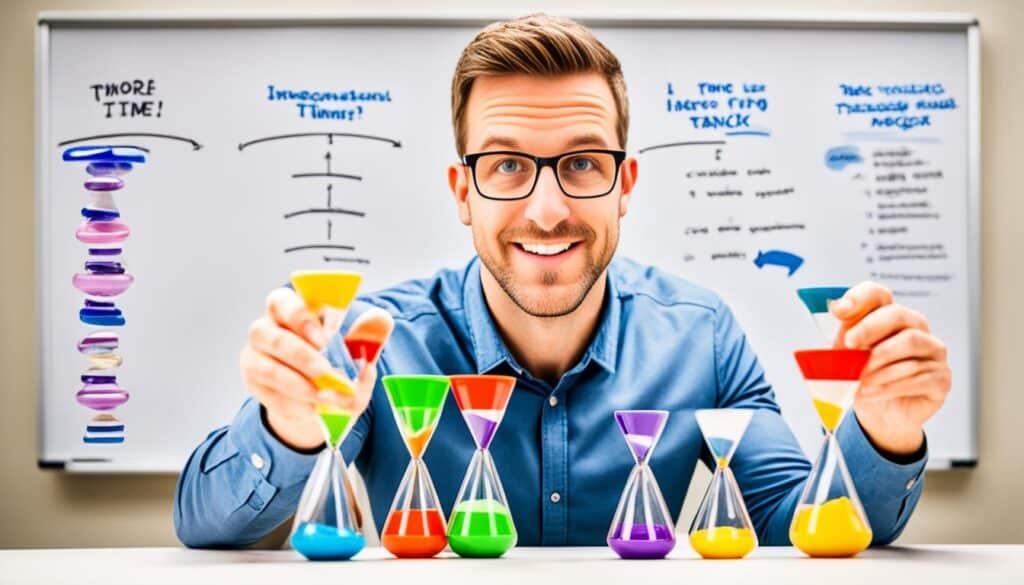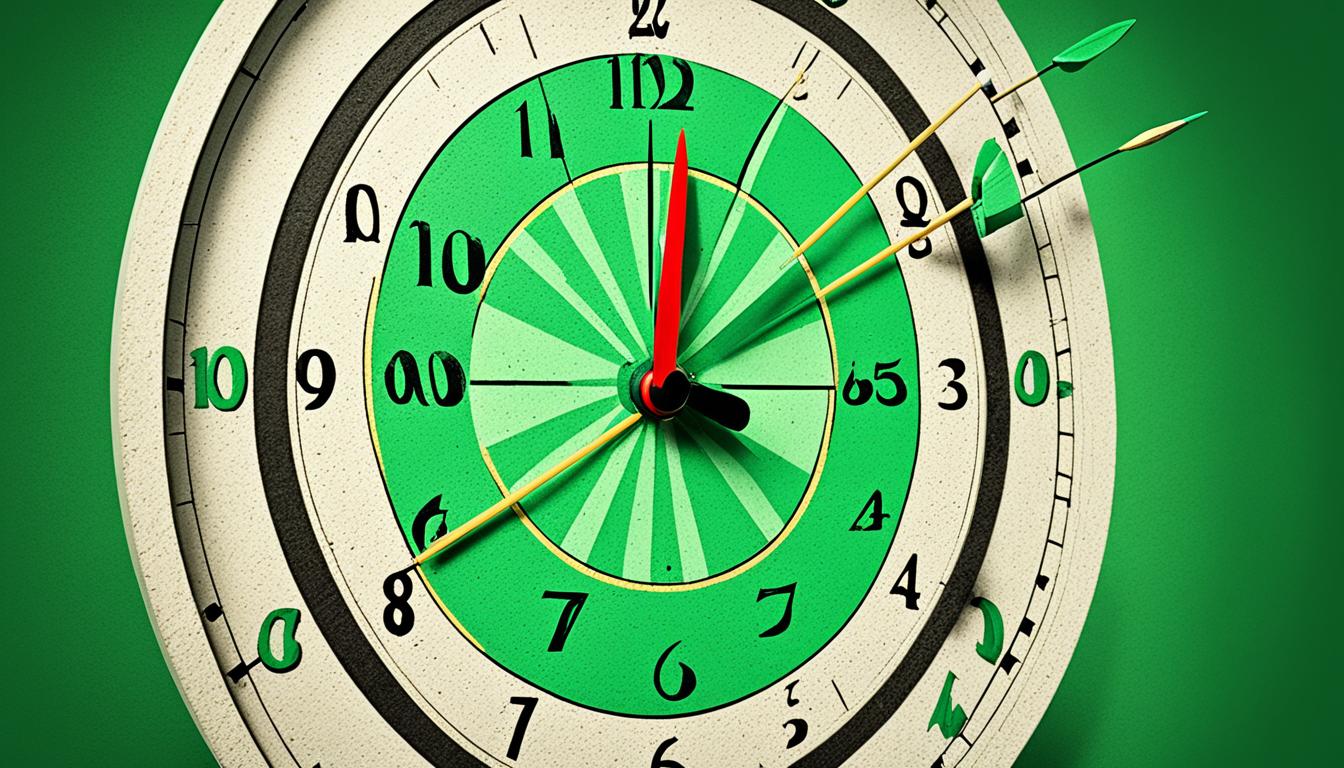Did you know 20% of your activities can account for 80% of your results?
Setting time management goals is essential for effectively managing your time and achieving your personal and professional objectives. These specific targets help prioritize tasks, set clear deadlines, and eliminate wasteful activities from your day-to-day. The SMART model is a common framework for developing time management goals, which stands for Specific, Measurable, Achievable, Relevant, and Time-Bound. By following this model, you can create well-defined, quantifiable, realistic goals aligned with your objectives and have clear timelines.
Key Takeaways:
- Setting time management goals is crucial for achieving desired outcomes.
- The SMART model helps create specific, measurable, achievable, relevant, and time-bound goals.
- Effective time management leads to improved productivity and work-life balance.
- Prioritizing tasks, delegating, and minimizing distractions are vital strategies for effective time management.
- Visual tools can enhance multitasking and task organization.
Benefits of Time Management Goals
Implementing time management goals offers several benefits. Proper time management allows you to have more time for yourself and loved ones, balance work and leisure, prioritize tasks effectively, focus on deep work without distractions, build a routine around critical tasks, prevent career burnout, and reduce stress. By setting specific time management goals, you can experience increased productivity, improved work efficiency, and better work-life balance.
When you prioritize your tasks and manage your time effectively, you can optimize your workflow and improve work efficiency. You can accomplish more in less time by allocating time for essential tasks and eliminating time-wasting activities. This boosts your productivity and allows you to achieve a better work-life balance.
Setting goals provides clarity and direction, helping you focus on what matters most. By defining clear objectives and deadlines, you improve your ability to prioritize tasks and make effective decisions. This reduces the chances of procrastination and enables you to progress towards your goals.
By implementing time management goals, you can establish a routine that aligns with your priorities and maximizes productivity. This routine helps you create structure and consistency in your day, enabling you to maintain focus and accomplish tasks efficiently.
Additionally, setting time management goals is crucial in preventing career burnout. By strategically allocating your time and energy, you can avoid overexertion and maintain a healthy work-life balance. This leads to increased job satisfaction and overall well-being.
Managing your time effectively also helps reduce stress. When you have a clear plan and set priorities, you can approach tasks confidently and avoid feeling overwhelmed. This promotes a positive mindset and allows you to work more efficiently.
Setting specific time management goals can improve work efficiency, improve work-life balance, reduce stress, and enhance overall productivity. Implementing goal-setting strategies and prioritizing your tasks enables you to maximize your time and reach your desired outcomes.
“Time is the most valuable resource. You can’t buy it, but you can manage it.” – Peter Turla
Implementing time management goals has numerous benefits that contribute to your overall well-being and success. You can improve work efficiency, enhance productivity, and achieve a better work-life balance by managing your time effectively.
Examples of Time Management Strategies
When it comes to managing your time effectively, there are various techniques you can incorporate into your daily routine. These strategies can help you stay focused, prioritize tasks, and make the most out of every minute. Here are some popular time management strategies that can enhance your productivity:
1. Time Blocking
Time blocking is a method that involves dividing your day into dedicated time chunks for specific tasks without any distractions. You can minimize interruptions and maintain a productive flow by allocating specific periods to focus on essential activities. Prioritize tasks by urgency and importance, and assign dedicated time slots for each. This technique ensures that you stay on track and complete the necessary tasks within the allocated time frame.
2. The 3/3/3 Rule
The 3/3/3 rule is a time management technique that efficiently prioritizes urgent and not-so-urgent tasks. With this method, you allocate three hours for three urgent tasks and another three hours for three less-pressing tasks. By setting aside dedicated time for these tasks, you can ensure that essential responsibilities are addressed promptly and prevent them from piling up.
3. The Pomodoro Technique
The Pomodoro technique is a time management strategy emphasizing working in focused bursts with regular breaks. This technique involves dividing your work into 25-minute intervals called “Pomodoros,” followed by short 5-minute breaks. After completing four Pomodoros, take a more extended break of 15-30 minutes. This method helps maintain concentration and prevents burnout by providing scheduled breaks to recharge.
4. Getting Things Done (GTD) Method
The Getting Things Done (GTD) method is a comprehensive approach to time management that emphasizes capturing, organizing, and prioritizing tasks effectively. This method encourages breaking down tasks into smaller, actionable steps and allocating specific time intervals for completing them. It allows you to tackle tasks head-on, allocate resources accordingly, and stay on top of your commitments.
By implementing these time management strategies, you can better prioritize your tasks, maintain focus, and progress steadily toward your goals. Experiment with different techniques and find the ones that work best for you. Remember, effective time management is crucial for maximizing productivity and achieving success.
Effective Time Tracking
Time tracking plays a crucial role in effective time management. By accurately measuring and analyzing how you spend your time, you can make informed decisions to optimize your productivity. Here are some productivity tips and time-tracking techniques to help you maximize your efficiency:
1. Record Time from Any Device
Utilize time tracking tools like ClickUp, which allow you to record your time from any device easily. Whether working on your computer, tablet, or smartphone, you can effortlessly track your time on different tasks and projects.
2. Set Time Estimates for Tasks
When you start a task, estimate how long you think it will take. By setting time estimates, you create a benchmark against which you can measure your actual performance. This helps you identify areas where you may be spending too much or too little time.
3. Monitor Progress with Weekly Scorecards
Tracking your time every week can provide valuable insights into your productivity patterns. Use weekly scorecards or reports from time tracking tools to review your time usage. These reports can show you how much time you’ve spent on different tasks, projects, or clients, allowing you to identify areas where you need to make adjustments.
Through adequate time tracking, you gain visibility into how you allocate your time and can make data-driven decisions to improve your productivity. Leveraging tools like ClickUp and employing these time-tracking techniques can optimize your time management efforts and achieve tremendous success.
| Benefits of Effective Time Tracking | Techniques |
|---|---|
| 1. Increased productivity | 1. Record time from any device |
| 2. Better time allocation | 2. Set time estimates for tasks |
| 3. Improved task prioritization | 3. Monitor progress with weekly scorecards |
| 4. Enhanced efficiency |
Effective time tracking is essential for optimizing your productivity. By implementing these productivity tips and time-tracking techniques, you can gain valuable insights and make data-driven decisions to improve your time management skills.

Task Prioritization and Organization
Task prioritization plays a crucial role in improving work efficiency. By prioritizing tasks effectively, you can ensure that you focus on high-value activities and make significant progress toward achieving your SMART goals.
“Eat the frog” method: This popular technique suggests tackling the most critical and challenging task first, leaving the easier ones for later. By conquering the most demanding task right away, you’ll gain momentum and reduce the risk of procrastination on important responsibilities.
To further enhance your task organization, leverage the following strategies:
- Custom Tags: Use custom tags to categorize and label your tasks according to different projects, priorities, or levels of urgency. This way, you can quickly identify and prioritize the most urgent and essential tasks.
- Filter Options: Take advantage of filtering options within your task management tool to view tasks based on specific criteria, such as due dates, project categories, or assigned team members. Filtering allows you to focus on relevant tasks efficiently.
- High-Priority To-Do Lists: Create separate to-do lists dedicated solely to high-priority tasks. This practice helps prevent critical tasks from getting buried among less essential activities and ensures they receive the attention they deserve.
By implementing effective task prioritization and organization techniques, you can streamline your workflow and allocate your time and energy to the most critical tasks. This proactive approach will lead to improved work efficiency and greater overall productivity.
Example of a High-Priority Task To-Do List:
| Task | Due Date |
|---|---|
| Prepare quarterly report | June 30th |
| Conduct client meeting | June 15th |
| Review and approve marketing campaign | June 10th |
| Finalize budget proposal | June 5th |
By referring to this high-priority to-do list, you can keep track of critical tasks and ensure they are completed on time.
Delegation for Effective Time Management
Delegating tasks is crucial for improving work efficiency and optimizing time management. By assigning low-value tasks to others or hiring a virtual assistant, you can free up more time to focus on critical tasks that directly contribute to your goals. Here are some delegation tips to help you improve your work efficiency:
- Communicate: When delegating tasks, ensure that you provide clear instructions and expectations to the person taking over the task. Communicate the desired outcomes, specific requirements, and deadlines or timelines that must be followed.
- Set timeline expectations: Establish realistic timelines for the completion of delegated tasks. This helps you and the person responsible for the task clearly understand when it should be completed, ensuring that it aligns with your overall time management goals.
- Trust your team members: Delegation requires trust in your team members’ abilities to handle the assigned tasks. Have confidence in their skills and provide support if needed. Trusting your team fosters a positive work environment and allows you to focus on other essential responsibilities.
You can significantly improve work efficiency and productivity by redistributing tasks and responsibilities through effective delegation. Delegating allows you to leverage the strengths and skills of your team members, enabling everyone to work toward achieving common time management goals.
“Delegation is not about getting rid of your responsibilities, but rather empowering others to contribute to the team’s success.” – Unknown
Remember that delegation is an ongoing process. Regularly assess your workload and identify tasks that can be delegated. This lightens your load and gives others opportunities to grow and develop professionally. Embrace delegation as a valuable tool for effective time management, and watch as your work efficiency improves.

Minimizing Distractions
Distractions can significantly hinder productivity. To minimize distractions, try implementing the following tips:
- Install notification blockers to prevent interruptions from social media, emails, and other apps.
- Put your phone on “Do Not Disturb” mode to avoid distractions from incoming calls and messages.
- Uninstall distracting apps or use app blockers to limit access during work hours.
- Turn off email notifications to reduce the temptation of constantly checking your inbox.
- Create a dedicated workspace free from external distractions like noise or clutter.
Breaking challenging tasks into smaller subtasks with achievable timelines can also help minimize procrastination. You can stay focused on your priorities and optimize your time management efforts by eliminating distractions.
Quote
“Distractions are the enemy of productivity. Stay focused, eliminate distractions, and watch your productivity soar.” – Brian Tracy
Productivity Tips
| Tip | Description |
|---|---|
| 1 | Install notification blockers |
| 2 | Put your phone on “Do Not Disturb” mode |
| 3 | Uninstall distracting apps |
| 4 | Turn off email notifications |
| 5 | Create a dedicated workspace |
Visual Tools for Multitasking
Visual tools play a crucial role in improving work efficiency and staying organized. These tools not only enhance multitasking but also make tasks more manageable. You can effectively prioritize tasks, manage deadlines, and monitor progress by leveraging visual organizational tools. Let’s explore some popular visual tools that can help boost your productivity:
Gantt Charts
Gantt charts are powerful visual tools for organizing tasks, tracking progress, and managing project timelines. With a Gantt chart, you can easily visualize your tasks, their durations, and dependencies. This allows you to identify potential bottlenecks and allocate resources accordingly. Using a tool like ClickUp’s Gantt chart view, you can schedule tasks, set dependencies, and get a comprehensive overview of your project’s status.
Kanban Boards
Kanban boards are widely used for agile project management and task tracking. They visually represent your workflow, allowing you to move tasks from one stage to another. With a Kanban board, you can easily see which tasks are in progress, pending, and completed. Tools like Trello offer intuitive Kanban board functionalities that enable efficient task management and team collaboration.
Flowcharts
Flowcharts help visualize processes and decision-making workflows. They provide a step-by-step representation of how tasks or information flow through different stages. Flowcharts help identify bottlenecks, improve communication, and streamline complex processes. You can create flowcharts using tools like Lucidchart or draw.io.
Mind Maps
Mind maps are great for brainstorming ideas, organizing thoughts, and connecting concepts. With a mind map, you can capture ideas, create hierarchies, and explore relationships visually. Tools like MindMeister or XMind offer user-friendly interfaces for building and collaborating on mind maps.
Integrating these visual tools into your workflow can significantly improve work efficiency, streamline task management, and enhance collaboration. Whether tracking project progress, managing team workflows, or organizing your tasks, these tools provide a clear and structured way to visualize your goals and stay on top of your work.
Now, let’s take a look at how these visual tools can be applied in practice with a real-life example:
| Task | Deadline | Status |
|---|---|---|
| Create website wireframes | April 15th | In progress |
| Design logo | April 20th | Not started |
| Develop homepage | April 25th | Not started |
| Test website functionality | April 30th | Not started |
In the above example, a Gantt chart can be used to visualize the project timeline and dependencies. The Kanban board can help track the progress of individual tasks, while the flowchart can illustrate the decision-making process for developing the website. Lastly, a mind map can be used to brainstorm ideas for the website’s design elements.
Incorporating these visual tools into your workflow can improve work efficiency, help you stay organized, and help you achieve better results. Experiment with different tools and find the best ones for your needs and preferences.
Conclusion
Effective time management is vital for maximizing productivity and achieving your desired outcomes. You can optimize your time management efforts and make significant progress towards your goals by implementing proven strategies such as time blocking, task prioritization, delegation, distraction elimination, and utilizing visual tools.
Remember that setting SMART goals is the foundation of effective time management. These goals should be Specific, Measurable, Achievable, Relevant, and Time-Bound. Regularly review and adjust your goals to stay on track and ensure they align with your priorities.
Stay motivated and accountable by tracking your progress and celebrating your achievements. Effective time management requires consistency, discipline, and maximizing your available time.
By mastering the art of time management and implementing these productivity strategies, you can take control of your schedule and achieve success in both your personal and professional life. Start today and unlock your full potential!
FAQ
What are time management goals?
Time management goals are specific targets that help prioritize tasks, set clear deadlines, and eliminate wasteful activities from your day-to-day. They are essential for effectively managing your time and achieving your personal and professional objectives.
What is the SMART model for setting time management goals?
The SMART model is a common framework used for setting time management goals. It stands for Specific, Measurable, Achievable, Relevant, and Time-Bound. By following this model, you can create goals that are well-defined, quantifiable, realistic, aligned with your overall goals, and have clear timelines.
What are the benefits of time management goals?
Implementing time management goals offers several benefits. It allows you to have more time for yourself and loved ones, strike a balance between work and leisure, prioritize tasks effectively, focus on deep work without distractions, build a routine around critical tasks, prevent career burnout, and reduce stress. By setting specific time management goals, you can experience increased productivity, improved work efficiency, and better work-life balance.
What are some examples of time management strategies?
Some examples of time management strategies include time blocking, where you break your day into dedicated time chunks for specific tasks without distractions; the Pomodoro Technique, which involves 25-minute work intervals followed by 5-minute breaks; and the Getting Things Done (GTD) method, which focuses on attacking a task head-on with set time intervals. Additionally, prioritizing tasks based on urgency and importance and delegating low-value tasks to others can also improve time management.
How can I effectively track my time?
Time tracking is a crucial aspect of effective time management. Tools like ClickUp offer features for easy time tracking, such as recording time from any device, setting time estimates for tasks, and monitoring progress using weekly scorecards. By tracking your time, you can gain insights into how you spend your days and make data-driven decisions to improve your productivity.
How can I prioritize and organize my tasks?
Task prioritization is key to improving work efficiency. The “Eat the frog” method suggests tackling the most critical and challenging task first, leaving easier tasks for later. Enhance your task organization by using custom tags, filter options, and high-priority to-do lists to identify and act on urgent tasks.
How can delegation help with time management?
Delegating tasks is a crucial aspect of effective time management. By assigning low-value tasks to others or hiring a virtual assistant, you can free up more time for high-value, critical tasks. Delegation requires clear communication, setting timeline expectations, and trusting your team members.
How can I minimize distractions to improve productivity?
To minimize distractions, you can install notification blockers, put your phone on “Do Not Disturb” mode, uninstall distracting apps, turn off email notifications, and create a dedicated workspace. Additionally, breaking challenging tasks into smaller subtasks with achievable timelines can help minimize procrastination.
What visual tools can I use for multitasking?
Visual tools like Gantt charts, Kanban boards, flowcharts, and mind maps can enhance multitasking and make tasks more manageable. ClickUp’s Gantt chart view, for example, enables effective task scheduling, progress tracking, and handling project bottlenecks.
Why is setting SMART goals important for time management?
Setting SMART goals for time management is a powerful strategy for improving productivity and achieving desired outcomes. By adopting strategies such as time blocking, task prioritization, delegation, distraction elimination, and utilizing visual tools, you can optimize your time management efforts and work towards accomplishing your goals more efficiently.





